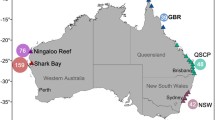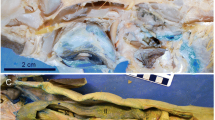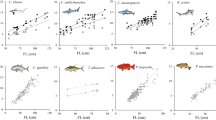Abstract
Bulk stable isotope analysis was used to assess the trophic level and foraging habitats of Caribbean reef sharks (Carcharhinus perezi) compared to three large sympatric predatory teleosts (the Nassau grouper Epinephelus striatus, black grouper Mycteroperca bonaci, and great barracuda Sphyraena barracuda) in an isolated Caribbean coral reef ecosystem. Models and empirical studies have suggested that the depletion of large-bodied sharks in coral reef ecosystems triggers a trophic cascade that could affect the benthic community, favoring algae over coral. The hypothesized cascade is based on the premise that sharks prey on large piscivorous teleost fish that in turn prey on key herbivorous fish. Analysis of nitrogen-stable isotopes (δ15N) from white muscle tissue revealed neither adult or juvenile Caribbean reef sharks were significantly enriched in 15N compared with sympatric predatory teleost species. Linear regression found no evidence of an ontogenetic increase in nitrogen with increasing body size for Caribbean reef sharks; however, there was a significant positive relationship between body size and carbon isotope (δ13C) values. These results suggest that Caribbean reef sharks in isolated systems do not act as the apex predator in coral reef ecosystems primarily feeding on large-bodied sympatric teleosts. Instead, Caribbean reef sharks form part of an upper trophic-level predator guild alongside large-bodied teleosts, which makes the predicted trophic cascade as a result of the removal of reef sharks unlikely. Moreover, the body size–δ13C relationship suggests Caribbean reef sharks exhibit ontogenetic and individual variation in where they feed. The ecological role of this species is, therefore, complex and contextual, similar to carcharhinid species in the Indo-Pacific, emphasizing the need to further elucidate the interactions between reef sharks and the overall coral reef ecosystem so as to best inform effective conservation and management of the species.




Similar content being viewed by others
References
Bascompte J, Melian CJ, Sala E (2005) Interaction strength combinations and the overfishing of a marine food web. Proc Natl Acad Sci USA 102:5443–5447. https://doi.org/10.1073/pnas.0501562102
Bond ME, Babcock EA, Pikitch EK, Abercrombie DL, Lamb NF, Chapman DD (2012) Reef sharks exhibit site-fidelity and higher relative abundance in marine reserves on the mesoamerican barrier reef. PLoS One 7:e32983
Bond ME, Valentin-Albanese J, Babcock EA, Abercrombie D, Lamb NF, Miranda A, Pikitch EK, Chapman DD (2017) Abundance and size structure of a reef shark population within a marine reserve has remained stable for more than a decade. Mar Ecol Prog Ser 576:1–10
Borer E, Seabloom E, Shurin J, Anderson K, Blanchette C, Broitman B, Cooper S, Halpern B (2005) What determines the strength of a trophic cascade? Ecology 86:528–537
Brooks EJ, Sims DW, Danylchuk AJ, Sloman KA (2013) Seasonal abundance, philopatry and demographic structure of Caribbean reef shark (Carcharhinus perezi) assemblages in the north-east Exuma Sound, The Bahamas. Mar Biol 160:2535–2546
Burkholder DA, Heithaus MR, Fourqurean JW, Wirsing A, Dill LM (2013) Patterns of top-down control in a seagrass ecosystem: could a roving apex predator induce a behaviour-mediated trophic cascade? J Anim Ecol 82:1192–1202
Casey JM, Baird AH, Brandl SJ, Hoogenboom MO, Rizzari JR, Frisch AJ, Mirbach CE, Connolly SR (2016) A test of trophic cascade theory: fish and benthic assemblages across a predator density gradient on coral reefs. Oecologia 183:161–175. https://doi.org/10.1007/s00442-016-3753-8
Castro J (1983) The sharks of North American waters. Texas A. & M. Press, College Station
Castro JI (2011) The sharks of North America. Oxford University Press, Oxford
Caut S, Angulo E, Courchamp F (2009) Variation in discrimination factors (Δ15N and Δ13C): the effect of diet isotopic values and applications for diet reconstruction. J Appl Ecol 46:443–453
Chapman MR, Kramer DL (2000) Movements of fishes within and among fringing coral reefs in Barbados. Environ Biol Fishes 57:11–24
Chapman DD, Pikitch EK, Babcock E, Shivji MS (2005) Marine reserve design and evaluation using automated acoustic telemetry: a case-study involving coral reef-associated sharks in the Mesoamerican Caribbean. Mar Technol Soc J 39:42–55
Chapman DD, Pikitch EK, Babcock EA, Shivji MS (2007) Deep-diving and diel changes in vertical habitat use by Caribbean reef sharks Carcharhinus perezi. Mar Ecol Prog Ser 344:271–275. https://doi.org/10.3354/meps06941
Compagno L (1999) Checklist of living elasmobranchs. Sharks, skates, and rays: the biology of elasmobranch fishes. The John Hopkins University Press, Baltimore
Compagno LJV, Dando M, Fowler SL (2005) A field guide to the Sharks of the World. Harper Collins, Glasgow
Cordeiro C, Mendes T, Harborne A, Ferreira C (2015) Spatial distribution of nominally herbivorous fishes across environmental gradients on Brazilian rocky reefs. J Fish Biol 89:939–958
Cortés E (1999) Standardized diet compositions and trophic levels of sharks. ICES J Mar Sci Journal du Conseil 56:707–717
Creel S, Christianson D (2008) Relationships between direct predation and risk effects. Trends Ecol Evol 23:194–201
Creel S, Winnie JA, Christianson D (2013) Underestimating the frequency, strength and cost of antipredator responses with data from GPS collars: an example with wolves and elk. Ecol Evol 3:5189–5200
Dahlgren C (2014) Review of the benefits of no-take zones: a report to the Wildlife Conservation Society. Wildlife Conservation Society, Bronx, NY
Done TJ (1992) Phase shifts in coral reef communities and their ecological significance. In: Jaccarini V, Martens E (eds) The ecology of mangrove and related ecosystems. Springer, Dordrecht, pp 121–132
Estes JA, Duggins DO (1995) Sea otters and kelp forests in Alaska: generality and variation in a community ecological paradigm. Ecol Monogr 65:75–100
Estes JA, Terborgh J, Brashares JS, Power ME, Berger J, Bond WJ, Carpenter SR, Essington TE, Holt RD, Jackson JB (2011) Trophic downgrading of planet earth. Science 333:301–306
Estrada JA, Rice AN, Lutcavage ME, Skomal GB (2003) Predicting trophic position in sharks of the north-west Atlantic Ocean using stable isotope analysis. J Mar Biol Assoc UK 83:1347–1350
Estrada JA, Aaron NR, Natanson LJ, Skomal GB (2006) Use of isotopic analysis of vertebrae in reconstructing ontogenetic feeding ecology in white sharks. Ecology 87:829–834. https://doi.org/10.2307/20069012
Finke DL, Denno RF (2004) Predator diversity dampens trophic cascades. Nature 429:407
Frisch A, Ireland M, Baker R (2014) Trophic ecology of large predatory reef fishes: energy pathways, trophic level, and implications for fisheries in a changing climate. Mar Biol 161:61–73. https://doi.org/10.1007/s00227-013-2315-4
Frisch AJ, Ireland M, Rizzari JR, Lönnstedt OM, Magnenat KA, Mirbach CE, Hobbs J-PA (2016) Reassessing the trophic role of reef sharks as apex predators on coral reefs. Coral Reefs 35:459–472
Froese R, Pauly D (eds) (2018) FishBase: concepts designs and data sources. WorldFish, Malaysia
Fry B (2006) Stable isotope ecology. Springer, Boston, MA
Gibson J (2003) Glover’s reef marine reserve & world heritage site management plan. Commissioned by the Coastal Zone Management Authority and Institute (CZMAI) on behalf of the Fisheries Department Belize City, Belize CZMAI, Belize City
Glazer RA, Delgado GA, Kidney JA (2003) Estimating queen conch (Strombus gigas) home ranges using acoustic telemetry: implications for the design of marine fishery reserves. Gulf Caribb Res 14:79–89
Heithaus M, Dill L, Marshall G, Buhleier B (2002) Habitat use and foraging behavior of tiger sharks (Galeocerdo cuvier) in a seagrass ecosystem. Mar Biol 140:237–248
Heithaus MR, Wirsing AJ, Frid A, Dill LM (2007) Behavioral indicators in marine conservation: lessons from a pristine seagrass ecosystem. Isr J Ecol Evol 53:355–370
Heithaus MR, Frid A, Wirsing AJ, Worm B (2008) Predicting ecological consequences of marine top predator declines. Trends Ecol Evol 23:202–210
Heithaus MR, Wirsing AJ, Burkholder D, Thomson J, Dill LM (2009) Towards a predictive framework for predator risk effects: the interaction of landscape features and prey escape tactics. J Animal Ecol 78(3):556–562
Heithaus MR, Wirsing A, Dill L (2012) The ecological importance of intact top-predator populations: a synthesis of 15 years of research in a seagrass ecosystem. Mar Freshw Res 63:1039–1050
Helfman GS (1986) Fish behaviour by day, night and twilight the behaviour of teleost fishes. Springer, Boston, MA, pp 366–387
Heupel MR, Knip DM, Simpfendorfer CA, Dulvy NK (2014) Sizing up the ecological role of sharks as predators. Mar Ecol Prog Ser 495:291–298
Hobson KA (1999) Tracing origins and migration of wildlife using stable isotopes: a review. Oecologia 120:314–326
Hussey NE, Aaron MacNeil M, McMeans BC, Olin JA, Dudley SF, Cliff G, Wintner SP, Fennessy ST, Fisk AT (2014a) Corrigendum to Hussey et al. Ecol Lett 17:768
Hussey NE, MacNeil MA, McMeans BC, Olin JA, Dudley SFJ, Cliff G, Wintner SP, Fennessy ST, Fisk AT (2014b) Rescaling the trophic structure of marine food webs. Ecol Lett 17:239–250. https://doi.org/10.1111/ele.12226
Jackson AL, Inger R, Parnell AC, Bearhop S (2011) Comparing isotopic niche widths among and within communities: SIBER - Stable Isotope Bayesian Ellipses in R. J Animal Ecol 80(3):595–602
Jud ZR, Layman CA (2012) Site fidelity and movement patterns of invasive lionfish, Pterois spp., in a Florida estuary. J Exp Mar Biol Ecol 414:69–74
Kim SL, del Rio CM, Casper D, Koch PL (2012) Isotopic incorporation rates for shark tissues from a long-term captive feeding study. J Exp Biol 215:2495–2500
Layman CA, Winemiller KO, Arrington DA, Jepsen DB (2005) Body size and trophic position in a diverse tropical food web. Ecology 86:2530–2535
Layman CA, Arrington AD, Montan CG, Post DM (2007) Can stable isotope ratios provide for community-wide measures of trophic structure? Ecology 88:42–48
Lepoint G, Michel L, Parmentier E, Frédérich B (2016) Trophic ecology of the seagrass-inhabiting footballer demoiselle Chrysiptera annulata (Peters, 1855); comparison with three other reef-associated damselfishes. Belg J Zool 146:21–32
Lowe CG, Wetherbee BM, Crow GL, Tester AL (1996) Ontogenetic dietary shifts and feeding behavior of the tiger shark, Galeocerdo cuvier, in Hawaiian waters. Environ Biol Fishes 47:203–211
Maljković A, Côté IM (2011) Effects of tourism-related provisioning on the trophic signatures and movement patterns of an apex predator, the Caribbean reef shark. Biol Cons 144:859–865
Matich P, Heithaus MR, Layman CA (2011) Contrasting patterns of individual specialization and trophic coupling in two marine apex predators. J Anim Ecol 80:294–305
McCann KS, Rasmussen J, Umbanhowar J (2005) The dynamics of spatially coupled food webs. Ecol Lett 8:513–523
McCauley DJ, Young HS, Dunbar RB, Estes JA, Semmens BX, Micheli F (2012) Assessing the effects of large mobile predators on ecosystem connectivity. Ecol Appl 22:1711–1717
Morris J, Akins J, Barse A, Cerino D, Freshwater D, Green S, Muñoz R, Paris C, Whitfield P (2009) Biology and ecology of the invasive lionfishes, Pterois miles and Pterois volitans. In: Proceedings of the Gulf and Caribbean Fisheries Institute, pp 409–414
Motta F, Moura R, Francini-Filho R, Namora R (1999) Elasmobrânquios dos recifes Manoel Luıs—MA. Resumos do XIII Encontro Brasileiro de Ictiologia 1:267
Mumby PJ, Dahlgren CP, Harborne AR, Kappel CV, Micheli F, Brumbaugh DR, Holmes KE, Mendes JM, Broad K, Sanchirico JN (2006) Fishing, trophic cascades, and the process of grazing on coral reefs. Science 311:98–101
Munroe S, Simpfendorfer C, Heupel M (2014) Defining shark ecological specialisation: concepts, context, and examples. Rev Fish Biol Fish 24:317–331
O’Farrell S, Bearhop S, McGill RA, Dahlgren CP, Brumbaugh DR, Mumby PJ (2014) Habitat and body size effects on the isotopic niche space of invasive lionfish and endangered Nassau grouper. Ecosphere 5:1–11
Olin JA, Hussey NE, Fritts M, Heupel MR, Simpfendorfer CA, Poulakis GR, Fisk AT (2011) Maternal meddling in neonatal sharks: implications for interpreting stable isotopes in young animals. Rapid Commun Mass Spectrom 25:1008–1016
Opitz S (1996) Trophic interactions in Caribbean coral reefs. WorldFish, Malaysia
Pace ML, Cole JJ, Carpenter SR, Kitchell JF (1999) Trophic cascades revealed in diverse ecosystems. Trends Ecol Evol 14:483–488
Papastamatiou YP, Friedlander AM, Caselle JE, Lowe CG (2010) Long-term movement patterns and trophic ecology of blacktip reef sharks (Carcharhinus melanopterus) at Palmyra Atoll. J Exp Mar Biol Ecol 386:94–102
Parker R, Mays R (1998) Southeastern US deepwater reef fish assemblages, habitat characteristics, catches, and life history summaries. US Department of Commerce, National Oceanic and Atmospheric Administration, National Marine Fisheries Service, Scientific Publications Office
Peterson BJ, Fry B (1987) Stable isotopes in ecosystem studies. Annu Rev Ecol Syst 18:293–320
Pikitch EK, Chapman DD, Babcock EA, Shivji MS (2005) Habitat use and demographic population structure of elasmobranchs at a Caribbean atoll (Glover’s Reef, Belize). Mar Ecol Prog Ser 302:187–197
Plass-Johnson J, McQuaid C, Hill J (2015) The effects of tissue type and body size on δ13C and δ15N values in parrotfish (Labridae) from Zanzibar, Tanzania. J Appl Ichthyol 31:633–637
Polis GA, Sears AL, Huxel GR, Strong DR, Maron J (2000) When is a trophic cascade a trophic cascade? Trends Ecol Evol 15:473–475
Post DM (2002) Using stable isotopes to estimate trophic position: models, methods, and assumptions. Ecology 83:703–718
Prugh LR, Stoner CJ, Epps CW, Bean WT, Ripple WJ, Laliberte AS, Brashares JS (2009) The rise of the mesopredator. Bioscience 59:779–791
Randall JE (1964) Contributions to the biology of the queen conch, Strombus gigas. Bull Mar Sci 14:246–295
Randall JE (1967) Food habits of reef fishes of the West Indies. Inst Mar Biol 1967:665–673
R Core Team (2016) R: A language and environment for statistical computing. R Foundation for Statistical Computing, Vienna, Austria. http://www.R-project.org/.
Ritchie EG, Johnson CN (2009) Predator interactions, mesopredator release and biodiversity conservation. Ecol Lett 12:982–998
Rizzari JR, Frisch AJ, Hoey AS, McCormick MI (2014) Not worth the risk: apex predators suppress herbivory on coral reefs. Oikos 123:829–836
Roff G, Doropoulos C, Rogers A, Bozec Y-M, Krueck NC, Aurellado E, Priest M, Birrell C, Mumby PJ (2016a) The ecological role of sharks on coral reefs. Trends Ecol Evol 31:395–407
Roff G, Doropoulos C, Rogers A, Bozec Y-M, Krueck NC, Aurellado E, Priest M, Birrell C, Mumby PJ (2016b) Reassessing shark-driven trophic cascades on coral reefs: a reply to Ruppert et al. Trends Ecol Evol 31:587–589
Romanuk TN, Hayward A, Hutchings JA (2011) Trophic level scales positively with body size in fishes. Glob Ecol Biogeogr 20:231–240
Rosa RS, Mancini P, Caldas JP, Graham RT (2006) Carcharhinus perezi. The IUCN red list of threatened species. The IUCN Red List of Threatened Species Version 20143
Rubenstein DR, Hobson KA (2004) From birds to butterflies: animal movement patterns and stable isotopes. Trends Ecol Evol 19:256–263
Ruppert JL, Fortin M-J, Meekan MG (2016) The ecological role of sharks on coral reefs: response to Roff et al. Trends Ecol Evol 31:586–587
Speed CW, Meekan MG, Field IC, McMahon CR, Abrantes K, Bradshaw CJA (2011) Trophic ecology of reef sharks determined using stable isotopes and telemetry. Coral Reefs 31:357–367. https://doi.org/10.1007/s00338-011-0850-3
Stevenson C, Katz LS, Micheli F, Block B, Heiman KW, Perle C, Weng K, Dunbar R, Witting J (2007) High apex predator biomass on remote Pacific islands. Coral Reefs 26:47–51
Tavares RAT (2009) Fishery biology of the Caribbean reef sharks, Carcharhinus perezi (Poey, 1876), in a Caribbean insular platform: Los Roques Archipelago National Park, Venezuela. Pan Am J Aquatic Sci 4:500–512
Terborgh J, Estes J, Paquet P, Ralls K, Boyd-Heger D, Miller B, Noss R (1999) The role of top carnivores in regulating terrestrial ecosystems. Wild Earth 9:42–56
Tilley A, Strindberg S (2012) Population density estimation of southern stingrays Dasyatis americana on a Caribbean atoll using distance sampling. Aquat Conserv Mar Freshw Ecosyst 23(2):202–229
Tilley A, López-Angarita J, Turner JR (2013a) Diet reconstruction and resource partitioning of a caribbean marine mesopredator using stable isotope bayesian modelling. PLoS One 8:e79560
Tilley A, López-Angarita J, Turner JR (2013b) Effects of scale and habitat distribution on the movement of the southern stingray Dasyatis americana on a Caribbean atoll. MEPS 482:169–179
Vander Zanden MJ, Cabana G, Rasmussen JB (1997) Comparing trophic position of freshwater fish calculated using stable nitrogen isotope ratios (δ15N) and literature dietary data. Can J Fish Aquat Sci 54:1142–1158
Ward-Paige CA, Mora C, Lotze HK, Pattengill-Semmens C, McClenachan L, Arias-Castro E, Myers RA (2010) Large-scale absence of sharks on reefs in the greater-Caribbean: a footprint of human pressures. PLoS One 5:e11968
Wetherbee BM, Cortés E, Bizzarro JJ (2004) Food consumption and feeding habits. In: Biology of sharks and their relatives. CRC Press, Boca Raton, USA, pp 225–246
Wirsing AJ, Ripple WJ (2010) A comparison of shark and wolf research reveals similar behavioral responses by prey. Front Ecol Environ 9:335–341
Wirsing AJ, Heithaus MR, Dill LM (2007) Fear factor: do dugongs (Dugong dugon) trade food for safety from tiger sharks (Galeocerdo cuvier)? Oecologia 153:1031–1040
Acknowledgements
This research was funded by grants from Earthwatch International (to DDC and EAB) and the Roe Foundation (to DDC). We would like to thank all the Earthwatch volunteers and Dr. Alex Tilley for their tireless efforts collecting the samples, and for providing additional samples, respectively. Captain Norlan Lamb, Ashbert Miranda, and the management and staff of Wildlife Conservation Society Belize and the Glover’s Reef Research Station provided outstanding logistical support. Furthermore, thanks to Anna Hussey and Aaron Fisk for assistance and mentorship in the lab and the Stony Brook students who helped prepare the samples.
Funding
This work was funded by grants from Earthwatch International (Grant number 7262541).
Author information
Authors and Affiliations
Corresponding author
Ethics declarations
Ethical approval
All applicable international, national, and/or institutional guidelines for the care and use of animals were followed. All procedures performed in studies involving animals were in accordance with the ethical standards of Stony Brook University and this work was carried out under the necessary research and animal care permits from the Government of Belize Ministry of Agriculture and Fisheries.
Conflict of interest
The authors declare that they have no conflicts of interest.
Additional information
Responsible Editor: J. K. Carlson.
Reviewed by G. Roff and an undisclosed expert.
Electronic supplementary material
Below is the link to the electronic supplementary material.
Rights and permissions
About this article
Cite this article
Bond, M.E., Valentin-Albanese, J., Babcock, E.A. et al. The trophic ecology of Caribbean reef sharks (Carcharhinus perezi) relative to other large teleost predators on an isolated coral atoll. Mar Biol 165, 67 (2018). https://doi.org/10.1007/s00227-018-3322-2
Received:
Accepted:
Published:
DOI: https://doi.org/10.1007/s00227-018-3322-2




